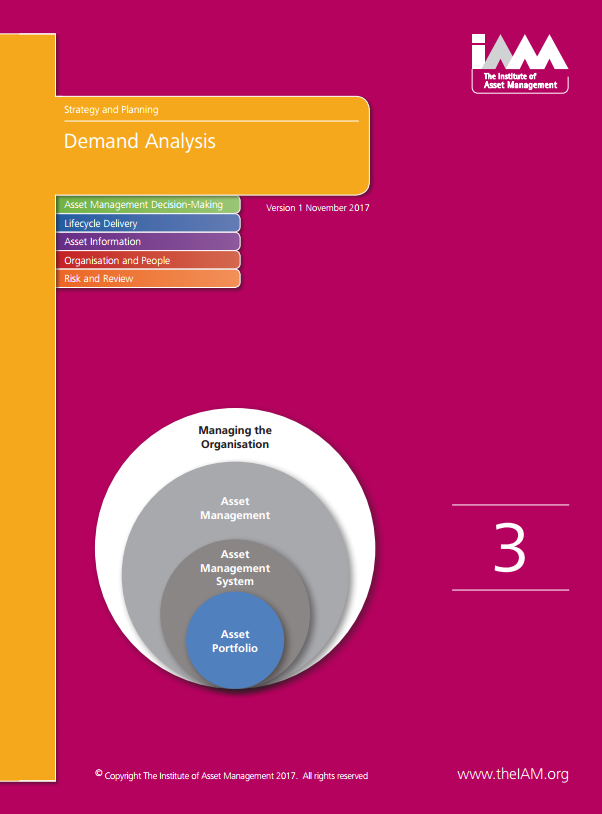01 Nov 2017
Subject 3: Demand Analysis
Version 1.0 November 2017
The Demand Analysis SSG provides guidance on how asset intensive organisations can understand, analyse and forecast demand in order to support strategic planning activities.
Demand plays an important role in an organisation's strategic investment planning - planing for an existing portfolio of assets or determining future requirements to expand their portfolio to meet changing demand.
It is important to assess demand in the context of an asset management system. Assessment of demand:
- aids with future cash-flow forecasting
- provides guidance on connectivity between local and organisational demand
- helps with portfolio planning and assessing working capital requirements
- provides the basis for analysing and adapting to influences on goods or services for each business unit
- matches the competitive strength of a business unit to the demand
- allows for those individuals and teams who interact with an organisation’s assets to react to demand
Preview This SSG By Clicking Here
With thanks to our sponsors of this publication.
| CONTENTS | |
|---|---|
| Acknowledgements | ii |
| 1 INTRODUCTION TO SUBJECT SPECIFIC GUIDANCE 1.1 Purpose of the SSGs 1.2 The SSGs in context 1.3 SSGs and the issue of Complexity versus Maturity 1.4 Further reading |
1 1 1 1 2 |
| 2 SCOPE OF THIS SSG | 2 |
| 3 WHAT DOES ‘DEMAND’ MEAN? | 3 |
| 4 UNDERSTANDING DEMAND 4.1 Demand types by sector |
5 6 |
| 5 CHANGING DEMAND 5.1 Economic growth 5.2 Consumer behaviour 5.3 Technology 5.4 Policy 5.5 Changes in price over time 5.6 The environment 5.7 Levels of service changes |
9 10 10 10 10 10 10 10 |
| 6 HIGH LEVEL PROCESS FOR DEMAND ANALYSIS | 11 |
| 7 STEP 1 - DEMAND ANALYSIS STRATEGY 7.1 Purpose 7.2 Objectives / requirements 7.3 Stakeholders map 7.4 Communication plan 7.5 Tools / Techniques strategy 7.6 Review policy 7.7 Changing demand |
13 13 13 13 14 14 17 17 |
| 8 STEP 2 - DEMAND ANALYSIS PLANNING 8.1 Demand scenarios 8.2 Assumptions 8.3 Frequencies / triggers 8.4 Input / data requirements 8.5 Output action plan 8.6 Tools / models configuration |
18 18 18 18 19 19 19 |
| 9 STEP 3 - CONDUCT DEMAND ANALYSIS 9.1 Step 3a - Review previous demand analysis outputs 9.2 Step 3b - Adjust inputs 9.3 Step 3c - Undertake analysis/ modelling 9.4 Step 3d - Sanity check of outputs 9.5 Step 3e - Save scenario outputs 9.6 Step 3f - Publish demand outputs |
21 21 21 21 22 22 22 |
| 10 STEP 4 - ACT UPON DEMAND ANALYSIS OUTPUTS | 23 |
| 11 CASE STUDIES 11.1 Sector Example: Potable water demand in the UK 11.2 Internal Demand Example: Automotive Component Manufacturing |
25 25 27 |
| 12 GLOSSARY | 28 |
| 13 REFERENCES | 29 |









